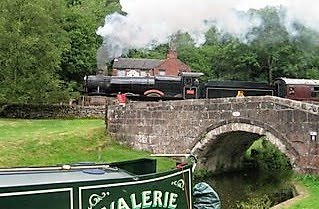Canal bridges come in all shapes and sizes, some old some new and some like this one at Kings Langley, takes Water Lane over the cut, have been replaced by a modern structure. It was originally the very common narrow brick arch.
What a large number of canal bridges have in common is the history that disappeared along with the working boats. The history that once surrounded this bridge has gone leaving no trace or at least very little.As is often the case I come across this history quite by chance when researching something else, in this case I was looking into the Ovaltine history.
In the picture above looking north through the original bridge the lock can be seen. Upon the bridge to the left is the Griffin pub and shop and to the right like a mirror image is the Boatman and shop.
The drinking laws closed the Griffin early so at closing time customers would cross the canal bridge and enjoy an extra 30 minutes drinking in the Boatman that benefited from Abbots Langley extended hours. Folk have re-called the glasses were returned across the bridge the following morning.
Today modern housing has replaced the pubs and shops. The brick wall and the fence still mark out the side access to the stables behind the Boatman pub. Across the bridge the trees have taken the place of the Griffin. Stabling was available at both pubs.
To understand what attracted so many working boats to tie up here overnight have a look at the map below. First though just count how many pubs are squeezed into this small area very close to the canal. The only one left is the Red Lion but that only exists as a private house. The beginning of the 20C. there were 14 pubs in the Kings Langley area.
The men would use the pub and the women would take advantage of the butcher and other shops being open till 9pm. although come wartime rationing this became 5.30pm. The most important requirement was the stabling. The horse was the heart of everything, no horse no income so the horse took precedence over pub and shop.
 An interesting story came up during my research featuring the shop pictured on the right.
An interesting story came up during my research featuring the shop pictured on the right.From 1855 to 1930 this was a butchers run by the Payne family. In 1881 Joseph Payne died and his son William came from Birmingham to run the shop.
William`s wife son and five daughters together with all their possessions traveled over several days by canal boat to take over the family business. Not one item was broken and William ran the shop until his death in 1930.
Another story was of the transport of night soil from London. This is human manure mixed with street sweepings and it cost £27 -$43 per boat load that covered 10 acres.
Newman Hatley farmed 500 acres and in the early 1800`s started to run his own boats delivering farm produce into London and returning with night soil.
His two boats cost £262-$420, he employed a bargeman and boy for £2.12.6d- $4.20c. Also another un-skilled man at 17s=$1.35. Three horses were the boats engines and the round trip took 10 days. He had tolls to pay but the boatload of night soil cost £12 at London a saving of £15-$24 but he also was shipping his own and others goods to London.
The Boatman pub.
Demolished 1963

Home Park paper mills.
The Red Lion has a Jacobean frontage.
It closed as a pub in 1979 and is the only one
still standing.

Toovey`s Mill and land was sold in 1978 and the 1936 grain silo that was a local landmark was demolished.



Golden Spray flour was one of the products of Tooley`s Mill.








4 comments:
It is to be hoped that Mr Hatley's crew thoroughly cleaned the boats out before returning to London with another load of farm produce!
Thanks Les. Another great insight into the lost working life of the canal system.
Best wishes
Alistair
"Toovey's lorry. An early 6 wheeled Scammell lorry, 1922.".
An articulated lorry, no less! Like all hauliers, if you can, carry more by adding a trailer, and don't worry about the brakes (or transmission chains) until they actually break.
The other interesting point is that cornering speeds were so low there was no need to rope, strap, or net, the load in place.
An interesting post, thankyou.
Hi Alistair
Would imagine he did. Clever man to see the potential of his own transport.
Les
Hi David
I remember when Jaq and I were last in the states the artics had an extra trailer at the back.
Les
Post a Comment